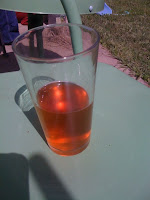
It is going to be slow going with the Trellis system, but we made some progress. We have found it difficult to source suitable poles, especially non-treated poles necessary for organic certification. Therefore, we went forward with our plans to harvest and use a small stand of black locust that has been growing on our property. An interesting note is that these trees have grown from nothing in the almost 10 years we have lived here. They came up in a flower bed in an area of the yard we don't really use. Through our neglect they became significant saplings after a couple of years, a point at which I felt some hesitation to cut them. I must admit a fondness for the black locust. It grows like a trash tree, yet grows straight, is one of the most dense hardwoods on earth and is extremely rot resistant. I grew up seeing these harvested for fence post in the mountains of NC. In any case, the photo on the right shows the area we harvested. They were not perfectly straight, but pretty darn good. I cleaned up the branches and nubs with the chainsaw and they look pretty good.
This is photo of one of the poles going in the ground. As the running title of this entry suggests, we dug the holes by hand. I did buy a hand auger for ~$60 which, in combination with my trusty old posthole digger, did a reasonably quick job. Probably took about 20 minutes per hole.
I was lucky enough to have my friend Mike provide some volunteer labor, which proved to be nice in the case of the hole digging, and necessary in the case of putting the poles in the holes. According to the Log Weight Calculator I found on the web (
http://www.woodweb.com/cgi-bin/calculators/calc.pl#top), these logs average about 200 lbs each. The process we used turned out to be very similar to stepping a mast on a sailboat, something that Mike and I have done together many times (though the masts are not nearly as heavy). We wanted to cant the end pole out a bit to even the stress on the pole. This led to a bit of red neck calculus and pontification (OK, no jokes about how long it takes an engineer and a PhD to put a pole in the ground). An indication of the heavy cogitation that occurred is clearly visible in photo on the left.

In the end, despite our best efforts to do things right, it turned out really well. We decided to spread the poles at 50' intervals, which meant two end poles and one center pole. I chose to use 3/16" galvanized cable with a working load of ~880 lbs. Some hop yards use significantly bigger, but I think this will be sufficient if we keep the overall run to no more than a couple hundred feet. Until we expand in the future it is a 100' run. I am making a real effort to keep the upfront cost in check, so we are trying to maximize the efficiency of efforts without compromising the long-term effort.
I can fortunately report that the pole erection process got faster with each pole and I think we can finish the yard in not too many weekends, IF WE CAN FIND ENOUGH POLES. That is our big problem right now. We got one row completed and I have enough locust for 1-2 more rows, but that leaves us 12 poles short. I will be scrounging for locust trees. If anyone has locust trees they want removed, let me know!
In closing, I find I can state that while the trellis system is THE major expense and technical challenge of establishing a hop yard, it is doable. I can also state that the cost of establishing a hop yard can probably vary by a few thousand quid per acre depending on the way in which construction of the trellis is approached.













 The processing went pretty well. The kids really like helping with the vacuum bag machine, with the 3 year old showing particular prowess at pushing the control buttons.
The processing went pretty well. The kids really like helping with the vacuum bag machine, with the 3 year old showing particular prowess at pushing the control buttons.



































